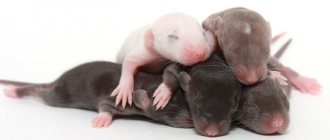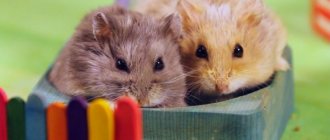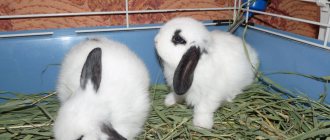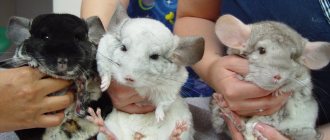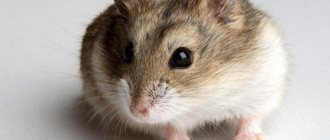Signs of imminent labor:
- activity decreases;
- loss of appetite;
- the birth canal is open.
How many days do hamsters give birth after mating depends on the type of animals, the number of fruits, and the conditions of detention. On average it is 20 days. The owner of a female hamster must know what to do if the hamster gives birth, because sometimes the animal is sold to pregnant women.
What do newborn hamsters look like?
Newborn hamsters are completely hairless, so they look like a red, swarming mass. Their ears and eyes are closed; only their sense of smell allows them to navigate. Babies may squeak loudly if they are cold or hungry. If the mother takes good care of the offspring, the babies do not make a sound. Sometimes the owner discovers that there are newborn hamsters in the house, by accident - when cleaning the cage, or when grown-up children of hamsters begin to crawl out of the nest.
Newborn hamsters
A baby hamster is no larger than the phalanx of a finger, weighing 1-2.5 g. In the first days, it can be difficult to count the offspring, especially since the female feeds the children, lying on them with her whole body. It is not recommended to look into the house so as not to disturb the hamster.
Although dwarf hamsters are much smaller in size, newborn Syrian hamsters are not very different in size from dwarf hamsters. The fact is that Syrians are multiple: the more children in one litter, the smaller the size of each hamster.
Newborn Hamster Size
Features of reproduction
Among the people, hamsters are known as very prolific animals, although this is only partly true. In captivity, hamsters actually breed all year round, but in the wild they obey instincts and reproduce only in the spring and summer. On average, a female gives birth 2–4 times per year, and the number of cubs in a litter varies greatly - from 1 to 18, but on average 8 animals are born in a litter.
How many children does a hamster give birth to?
The reproductive abilities of these rodents have long been the subject of jokes. Their fertility is really high, especially at home, when hamsters do not hibernate and receive an abundance of food. The ability to reproduce rapidly is a quality that makes rodents so popular as laboratory animals.
Hamsters can give birth to a different number of babies depending on the species and conditions of detention. It is quite precisely known how many hamsters are born to Djungarians - from 4 to 6 pieces. Rarely – 8-9 cubs. Due to their size, dwarf hamsters are not as fertile. But having learned how many hamsters a Syrian hamster can give birth to, an amateur breeder sometimes grabs his head. The average number is 6-10 babies, but sometimes there are 16-18, occasionally even 20 pieces.
The number of babies a hamster can give birth to - both the Djungarian and the Syrian - does not correspond to the number that the female is able to feed. Some of the numerous offspring die or are devoured by the mother. Therefore, the number of surviving hamster babies does not exceed 10-12.
Complications during childbirth
Toxicosis
A disease that occurs in the last days of pregnancy. Leads to the death of the female and brood during childbirth or in the first days after. There is no cure.
Pathology of childbirth
In females older than 10 months, the joints of the pelvic bones lose their elasticity, which is why the animal cannot give birth. Large fruiting is possible if there are few cubs (1-3 pieces). In such situations, strong contractions of the uterus cannot push the fetus out. If the female pushes for more than 10-15 minutes, and the baby does not appear, a caesarean section is necessary.
How long it takes hamsters to give birth depends on the number of children. The mother can rest for a long time between the birth of her babies, and even eat. There should be no unproductive fights.
Death of fetuses in the uterus
With infections, poor nutrition or genetic deformities, the cubs may die. The female is unable to give birth and dies from sepsis. Treatment is surgery to remove the uterus.
How to care for newborn hamsters
A newborn Djungarian hamster is a helpless creature that is completely dependent on the actions of its mother. Cubs need warmth and food. The temperature in the room is maintained at least 21 C, but not higher than 25 C. If the female takes care of the offspring on her own, the owner will not need to care for the born hamsters.
It is extremely rare to raise babies under 10 days of age without a mother.
At home, caring for cubs comes down to caring for their mother. In the case of rodents, the best help is to stay out of the way. The female and children need privacy. Baby Djungarian hamsters will be in mortal danger if their mother is stressed.
Host actions:
Feeding
Usually the owner feeds the hamster, and the hamster feeds its babies. The female must be provided with plenty of water and food, including a source of protein and succulent food. If the mother has enough milk, there is no need to feed the cubs. You can throw grated carrots, low-fat cottage cheese and other foods into the baby’s nest if the hamster does not do this. Food is placed in the cage with the expectation that any product can be tasted by Djungarian babies.
Arrangement of the cage:
- Litter.
It's good if there is a house in the cage. If it is not there, you need to put a small cardboard box. If the female is provided with materials for construction, she will cope with the arrangement of the home herself. In addition to sawdust or other filler, paper towels are placed in the cage. It is forbidden to use cotton wool or rags; these materials are dangerous for baby hamsters (they can get entangled and suffocate). General cleaning is not carried out for at least 2 weeks.
- Safety.
Sometimes, even with a caring mother, the question arises - what to do with newborn hamsters that have fallen out of the nest. To prevent the baby from freezing or catching a cold, it is better to return him to his brothers and sisters. But not with your hand, but with a spoon on a long handle.
At 10-12 days, a newborn hamster begins to explore the world around him; he cannot be kept in the nest. There should be no differences in height (tiers) in the cage; pay attention to the distance between the bars (whether the baby will fall out). Do not place water in an open bowl. Feeders are placed so that they are accessible to babies.
Injuries at 3-4 weeks of age are possible in the running wheel. It is interesting to watch young Djungarian hamsters during games, but in this case the wheel should not stand on a stand (hang on the wall) and be solid, without crossbars.
- Privacy.
The cage should be in a quiet place so that no loud noises can be heard. It is protected from the sun's rays. Drafts are not allowed. Children are explained that caring for small hamsters takes up all their free time, and they cannot pick them up for play for 2-3 weeks.
When the animals grow up and are placed in other cages, caring for dwarf animals includes daily hand training. Otherwise, they may bite the hands of the new owner. Syrians are more friendly, but detailed instructions on how to care for a small hamster will be useful.
Solo content or in company
Campbell's hamsters get along well together. Sometimes the female and male jungariki are loyal to each other. But this is rather an exception to the rule. Fighting for territory is more typical for these rodents, so it is better to keep them separately, placing the female with the male only during mating. Even a Campbell's hamster will do better alone before giving birth.
Don't handle small hamsters with your bare hands
How do hamsters grow?
The reproduction of Djungarian hamsters, like the reproduction of Syrian hamsters, occurs extremely intensively. Hamsters and their babies are the embodiment of rapid development. First, the fetuses gain weight in the womb in a matter of days, and then continue to grow just as quickly after birth.
A day after birth, red, naked babies turn pink or darken, depending on the color of the fur that has broken through. By day 4, you can distinguish the color of dark hamsters; light ones look pink, but not hairless.
Newborn hamsters are 4 days old
A newborn hamster is a rather helpless creature. All they can do is squeak and move their paws. They find the mother's nipple by smell. On days 5-6, the cubs' ears protrude and they begin to hear.
Hamsters grow very quickly. At the age of 1 week, babies are already covered with fluff and begin to try solid food. Like true rodents, they were equipped with sharp teeth from the first day of life. The first food after mother's milk is often your own feces. Coprophagia is a natural process necessary to populate the intestines with the correct microflora. The babies also try the food brought by the female to the house.
Newborn hamsters aged 1 week
On days 9-12 after birth there is a real developmental leap. The hamsters begin to crawl out of the nest, although their eyes are still closed. They eat solid food - greens and vegetables, grain mixture. They learn to use the toilet corner, being naturally clean. On the first day of such walks, the hamster may worry and try to gather the babies back into the nest. Pretty soon she gets tired of it, and the kids, staggering and falling, scatter around the cage. By the time they leave the nest, they are completely covered with hair.
Newborn hamsters are 9-12 days old
When do hamsters open their eyes?
Immediately after birth, the cubs are blind, their eyes are tightly closed. Regardless of what day hamsters open their eyes, this is a new stage in the lives of babies. From this moment on, they begin to get used to being handled, and the hamsters themselves actively explore their surroundings.
The eyelids begin to open slightly from the 13th day of life, narrow slits are visible. On the 14th day or a little later, by the 16th day, the eyes open completely. Djungarians open their eyes a little earlier than Syrians, sometimes on the 12th day, which is explained by the longer pregnancy of dwarf animals.
Newborn hamsters 13-16 days
Development after 2 weeks
Starting from the 15th day, the mother is no longer able to tolerate grown offspring. The owner has to make sure that the hamsters sleep together in a warm place, returning stray animals to the house. At 15-16 days, babies are quite dexterous - they wash themselves and overcome obstacles. At 17-20 days, baby hamsters, Djungarians and Syrians, begin to use a running wheel, if given the opportunity. After 20 days, the animals can already feed on their own.
It is difficult to say at what point a young hamster becomes an adult. The age of puberty does not correspond to how long hamsters grow. Pregnancy is possible as early as one month of age, active growth continues until 2.5-3 months. A hamster can gain weight and mate for up to 4-5 months. After this, the increase in the size of the animal can only be associated with obesity, and not growth.
Where to keep the male: together with the babies or separately
If you have not done this before, the male should be removed before giving birth or immediately after the offspring appear. There is a high probability that his instincts will take over and he will eat all the cubs.
In addition, within a day the female is ready to mate again. Repeated pregnancy at this time is extremely undesirable, because it will lead to exhaustion of the hamster and can cause the death of both the mother and the newborn offspring.
You should not interfere in the lives of newborns
When can you handle newborn hamsters?
During the first two weeks after the birth of the offspring, it is not recommended to stick your hand into the cage, even to leave food. Cleaning the cage is prohibited. Touching newborn hamsters means putting their lives at risk .
The female can eat the cubs by smelling someone else's scent.
No matter how much curiosity there is, there is no need to pick up or stroke babies. Sometimes droppings are weighed for scientific purposes, or a dropped baby needs to be returned to the nest. Then the animal is taken not with the hand, but with a spoon or other suitable object. If you still need to pick it up, you need to use latex gloves and dump the baby in the toilet corner before returning it to the mother.
Babies begin to get used to being handled at the age when they can already survive without the care of a female, that is, no earlier than 2 weeks. In order not to count down the days until the moment when you can meet the hamsters, you need to focus on opening your eyes (do not touch blind children).
The age of 14-21 days is the optimal time for the first acquaintance.
Diet of a pregnant hamster
When a dzhungarik is pregnant, it requires good care, which includes providing adequate nutrition. During the period of bearing cubs, the hamster needs more protein and vitamins.
Therefore, her diet must include:
- boiled chicken breast without salt;
- egg white;
- skim cheese;
- vegetables – broccoli, cucumbers, zucchini, carrots;
- fresh herbs or herbal granules;
- branches of fruit trees.
There should always be clean drinking water in the drinking bowl. You need to put a lick stone for rodents in the cage. With its help, a pregnant dwarf will satisfy the increased need for minerals.
When can you give away hamsters after birth?
Hamsters cannot be given away immediately after weaning. They are divided into two groups by gender and placed in separate cages. This should be a full-fledged home with a drinking bowl, a house, a wheel and other toys. The cage for dwarf hamsters should be no smaller in size than for Syrian hamsters.
When the female relinquishes her responsibility for caring for the children, the owner’s troubles increase. It is not surprising that people are interested in at what age young animals can be given away. Moving to a new home is a lot of stress for Djungarian babies. It is optimal to distribute them at the age of 1.5-2 months, i.e. 6-8 weeks.
As a rule, breeders try to give away animals early. After all, at 7-8 weeks fights for territory may begin, and each young hamster will need to be provided with an individual cage. In a good nursery, the grown rodents are resistant to disease and are accustomed to handling. Along with the hamster, you should give some used litter and food for several days. A familiar smell and familiar diet reduce the stress of moving.
Does pregnancy differ between species?
In the table we note what behavioral features are characteristic of different hamsters.
| Aggression towards the male | Nesting behavior | |
| Syrian | It appears brightly, the female can injure or even kill the male, after mating it is necessary to place them in different cages | Very pronounced |
| Dzungarian | Maybe, but sometimes absent (manifests individually), it is recommended to separate | Characteristic |
| Campbell | The male can be with the female and even participate in raising the offspring | Present |
What to feed a baby hamster
Newborns
If the cubs are left without a mother, or the female does not have milk, the owner can feed them. The task is not easy: small hamsters need to be fed every 1.5 hours. Use soy-based infant formula 0+, dissolving and heating according to instructions. Sometimes they take Royal Canin cat milk replacer.
Each baby is fed individually from a pipette or insulin syringe without a needle. To prevent the animal from choking, it is held in a column, and milk is poured in small portions. It is advisable to massage the tummy after each feeding, monitor the presence of stool, and keep it warm.
Most hamsters die if their mother does not feed them, even when the breeder makes every effort to preserve the offspring. The reasons are different - aspiration pneumonia when milk gets into the respiratory tract, infections (the mixture does not contain maternal antibodies and does not provide strong immunity).
Hamster feeding
Babies have a greater chance of survival if they manage to find an adoptive mother - a female who has recently given birth and has a small litter. The babies are rolled around in the hamster’s toilet corner, then mixed with the “native” hamsters.
Age 1-3 weeks
When artificially feeding offspring, the sooner the hamsters start eating themselves, the better. After just a few days, the milk mixture is mixed with ground grain feed and vegetable purees are given.
Vegetable puree for babies
At 1.5 weeks of age, small hamsters can eat solid food and their chances of survival increase dramatically. Sprouted wheat, oats, a boiled egg, grated carrots and other vegetables are placed in the feeder every day. From 2 weeks of age, small hamsters need to be fed every 4 hours (6 times a day). The mixture and ground food are mixed until a paste of creamy consistency is obtained.
For both dwarf and Syrian hamsters, when feeding young animals, you need to focus on the list of permitted products. If the babies are raised by their mother, she carries her food into the nest, so they learn what the adults eat.
From 3 weeks, the cubs are no longer fed from a syringe, but the mixture is poured into a bowl.
Rodent nutrition
To get healthy and strong offspring, you need to properly feed the breeding hamsters before mating. Also, the quality of nutrition of a pregnant female determines whether the babies will be healthy or not. Therefore, carefully choose what to feed your pets.
Individuals should be well-fed, but not fat. Therefore, you should not abuse foods that contain fat and carbohydrates. Give preference to vitamin comas.
20-25 days before the planned mating, inspect the breeding rodents. For those that are underweight, supplement your diet with nutritious food. For those pets that have become obese, switch them to a light diet and increase physical activity (let them go for walks more often, put more toys designed for active recreation in the cage).
The daily diet of hamsters preparing for mating is as follows: 10 g of vegetables, 5 g of hay, 10 g of cereals (barley, oats, wheat), 1 g of tomato juice, 5 g of corn, 0.05 g of dry yeast.
